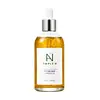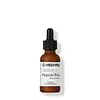What's inside
What's inside
 Key Ingredients
Key Ingredients

 Benefits
Benefits

 Concerns
Concerns

No concerns
 Ingredients Side-by-side
Ingredients Side-by-side

Water
Skin ConditioningGlycerin
HumectantButylene Glycol
HumectantDipropylene Glycol
Humectant1,2-Hexanediol
Skin ConditioningNiacinamide
SmoothingPolyglycerin-3
HumectantAdenosine
Skin ConditioningBeta-Glucan
Skin ConditioningArginine
MaskingDipotassium Glycyrrhizate
HumectantSodium Hyaluronate
HumectantMallotus Japonicus Bark Extract
Skin ConditioningYeast Extract
Skin ConditioningHelichrysum Arenarium Extract
AntiseborrhoeicCopper Tripeptide-1
Skin ConditioningAcetyl Tetrapeptide-2
Skin ConditioningCarbomer
Emulsion StabilisingDextran
Hydroxyethylcellulose
Emulsion StabilisingCaramel
Cosmetic ColorantGlyceryl Acrylate/Acrylic Acid Copolymer
HumectantTrifluoroacetyl Tripeptide-2
Skin ConditioningXanthan Gum
EmulsifyingBoron Nitride
AbsorbentPvm/Ma Copolymer
Emulsion StabilisingAgar
MaskingGellan Gum
Calcium Alginate
MaskingCaprylyl Glycol
EmollientGlucosylrutin
AntioxidantPalmitoyl Tripeptide-5
Skin ConditioningTetradecyl Aminobutyroylvalylaminobutyric Urea Trifluoroacetate
Skin ConditioningMagnesium Chloride
Disodium EDTA
Water, Glycerin, Butylene Glycol, Dipropylene Glycol, 1,2-Hexanediol, Niacinamide, Polyglycerin-3, Adenosine, Beta-Glucan, Arginine, Dipotassium Glycyrrhizate, Sodium Hyaluronate, Mallotus Japonicus Bark Extract, Yeast Extract, Helichrysum Arenarium Extract, Copper Tripeptide-1, Acetyl Tetrapeptide-2, Carbomer, Dextran, Hydroxyethylcellulose, Caramel, Glyceryl Acrylate/Acrylic Acid Copolymer, Trifluoroacetyl Tripeptide-2, Xanthan Gum, Boron Nitride, Pvm/Ma Copolymer, Agar, Gellan Gum, Calcium Alginate, Caprylyl Glycol, Glucosylrutin, Palmitoyl Tripeptide-5, Tetradecyl Aminobutyroylvalylaminobutyric Urea Trifluoroacetate, Magnesium Chloride, Disodium EDTA
Water
Skin ConditioningButylene Glycol
HumectantHydrogenated Polyisobutene
Emollient1,2-Hexanediol
Skin ConditioningHydrolyzed Collagen
EmollientPolyacrylamide
Lactobacillus/Pumpkin Ferment Extract
Skin ConditioningLactobacillus/Soybean Ferment Extract
Skin ConditioningC13-14 Isoparaffin
EmollientPolysorbate 20
EmulsifyingArginine
MaskingLactobacillus/Punica Granatum Fruit Ferment Extract
Skin ConditioningLactobacillus/Wasabia Japonica Root Ferment Extract
AntioxidantSodium Hyaluronate
HumectantEthylhexylglycerin
Skin ConditioningSaccharomyces/Grape Ferment Extract
Skin ConditioningCarbomer
Emulsion StabilisingAllantoin
Skin ConditioningAcrylates/C10-30 Alkyl Acrylate Crosspolymer
Emulsion StabilisingSaccharomyces Ferment Filtrate
HumectantLaureth-7
EmulsifyingBifida Ferment Lysate
Skin ConditioningDisodium EDTA
Adenosine
Skin ConditioningLeontopodium Alpinum Callus Culture Extract
AntioxidantParfum
MaskingHydrolyzed Elastin
EmollientGardenia Florida Fruit Extract
Skin ConditioningAnemarrhena Asphodeloides Root Extract
Skin ConditioningInonotus Obliquus Extract
Skin ConditioningElaeis Guineensis Oil
EmollientCopper Tripeptide-1
Skin ConditioningAcetyl Hexapeptide-8
HumectantOligopeptide-32
AntiseborrhoeicOligopeptide-29
AntioxidantPalmitoyl Pentapeptide-4
Skin ConditioningWater, Butylene Glycol, Hydrogenated Polyisobutene, 1,2-Hexanediol, Hydrolyzed Collagen, Polyacrylamide, Lactobacillus/Pumpkin Ferment Extract, Lactobacillus/Soybean Ferment Extract, C13-14 Isoparaffin, Polysorbate 20, Arginine, Lactobacillus/Punica Granatum Fruit Ferment Extract, Lactobacillus/Wasabia Japonica Root Ferment Extract, Sodium Hyaluronate, Ethylhexylglycerin, Saccharomyces/Grape Ferment Extract, Carbomer, Allantoin, Acrylates/C10-30 Alkyl Acrylate Crosspolymer, Saccharomyces Ferment Filtrate, Laureth-7, Bifida Ferment Lysate, Disodium EDTA, Adenosine, Leontopodium Alpinum Callus Culture Extract, Parfum, Hydrolyzed Elastin, Gardenia Florida Fruit Extract, Anemarrhena Asphodeloides Root Extract, Inonotus Obliquus Extract, Elaeis Guineensis Oil, Copper Tripeptide-1, Acetyl Hexapeptide-8, Oligopeptide-32, Oligopeptide-29, Palmitoyl Pentapeptide-4
Ingredients Explained
These ingredients are found in both products.
Ingredients higher up in an ingredient list are typically present in a larger amount.
1,2-Hexanediol is a synthetic liquid and another multi-functional powerhouse.
It is a:
- Humectant, drawing moisture into the skin
- Emollient, helping to soften skin
- Solvent, dispersing and stabilizing formulas
- Preservative booster, enhancing the antimicrobial activity of other preservatives
Adenosine is in every living organism. It is one of four components in nucleic acids that helps store our DNA.
Adenosine has many benefits when used. These benefits include hydrating the skin, smoothing skin, and reducing wrinkles. Once applied, adenosine increases collagen production. It also helps with improving firmness and tissue repair.
Studies have found adenosine may also help with wound healing.
In skincare products, Adenosine is usually derived from yeast.
Learn more about AdenosineArginine is an amino acid that is important for human development. Your body uses is it to produce hair keratin and skin collagen.
As a cosmetic ingredient, Arginine has antioxidant properties and can also help repair damaged skin. This ingredient is derived either synthetically or from animals.
Arginine isn't fungal acne safe when used in the presence of other lipids (fats, fatty acids, oils, esters, etc). Oils and fats occur naturally within the skin, so take caution when using Arginine if you're prone to fungal acne.
Learn more about ArginineButylene Glycol (or BG) is used within cosmetic products for a few different reasons:
Overall, Butylene Glycol is a safe and well-rounded ingredient that works well with other ingredients.
Though this ingredient works well with most skin types, some people with sensitive skin may experience a reaction such as allergic rashes, closed comedones, or itchiness.
Learn more about Butylene GlycolCarbomer is a polymer of acrylic acid. Its main role is to create a gel consistency.
A high amount of carbomer can cause pilling or balling up of products. Don't worry, most products contain 1% or less of carbomer.
Copper Tripeptide-1 (GHK-Cu) is a skin repairing ingredient known for its ability to boost collagen, improve firmness, and support skin regeneration.
It is a complex made up of a naturally occurring peptide (glycine-histidine-lysine) and copper, an essential trace element.
While studying wound healing, researchers noticed GHK-Cu stimulated hair follicle enlargement and growth by keeping hair in its active growth phase longer. This has made it a promising ingredient for hair regrowth treatments.
Some people have reported increased facial hair. While GHK-Cu can make your hair follicles bigger, it usually doesn’t turn soft, barely-visible facial hairs into thick, dark ones.
Anecdotal reports suggest that overusing copper peptides might lead to premature aging due to excess free copper or enzyme imbalances. This claim isn’t backed by large-scale studies.
Unfortunately, there are limited human studies for this ingredient. While early results are promising, many studies are either small, in-vitro, or not rigorously controlled.
For example, there is a 1998 study that explored the effects of copper tripeptide, vitamin C, tretinoin, and melatonin on skin repair and collagen synthesis.
After one month, increased procollagen production was seen in 7 out of 10 participants using copper tripeptide (more than those using vitamin C, melatonin, or tretinoin.
While the study was exploratory, it offers early evidence that copper tripeptide may support collagen production. Larger, well-designed trials are still needed to confirm its potential and understand individual responses.
Read more about other common types of peptides here:
Learn more about Copper Tripeptide-1Disodium EDTA plays a role in making products more stable by aiding other preservatives.
It is a chelating agent, meaning it neutralizes metal ions that may be found in a product.
Disodium EDTA is a salt of edetic acid and is found to be safe in cosmetic ingredients.
Learn more about Disodium EDTASodium Hyaluronate is hyaluronic acid's salt form. It is commonly derived from the sodium salt of hyaluronic acid.
Like hyaluronic acid, it is great at holding water and acts as a humectant. This makes it a great skin hydrating ingredient.
Sodium Hyaluronate is naturally occurring in our bodies and is mostly found in eye fluid and joints.
These are some other common types of Hyaluronic Acid:
Learn more about Sodium HyaluronateWater. It's the most common cosmetic ingredient of all. You'll usually see it at the top of ingredient lists, meaning that it makes up the largest part of the product.
So why is it so popular? Water most often acts as a solvent - this means that it helps dissolve other ingredients into the formulation.
You'll also recognize water as that liquid we all need to stay alive. If you see this, drink a glass of water. Stay hydrated!
Learn more about Water